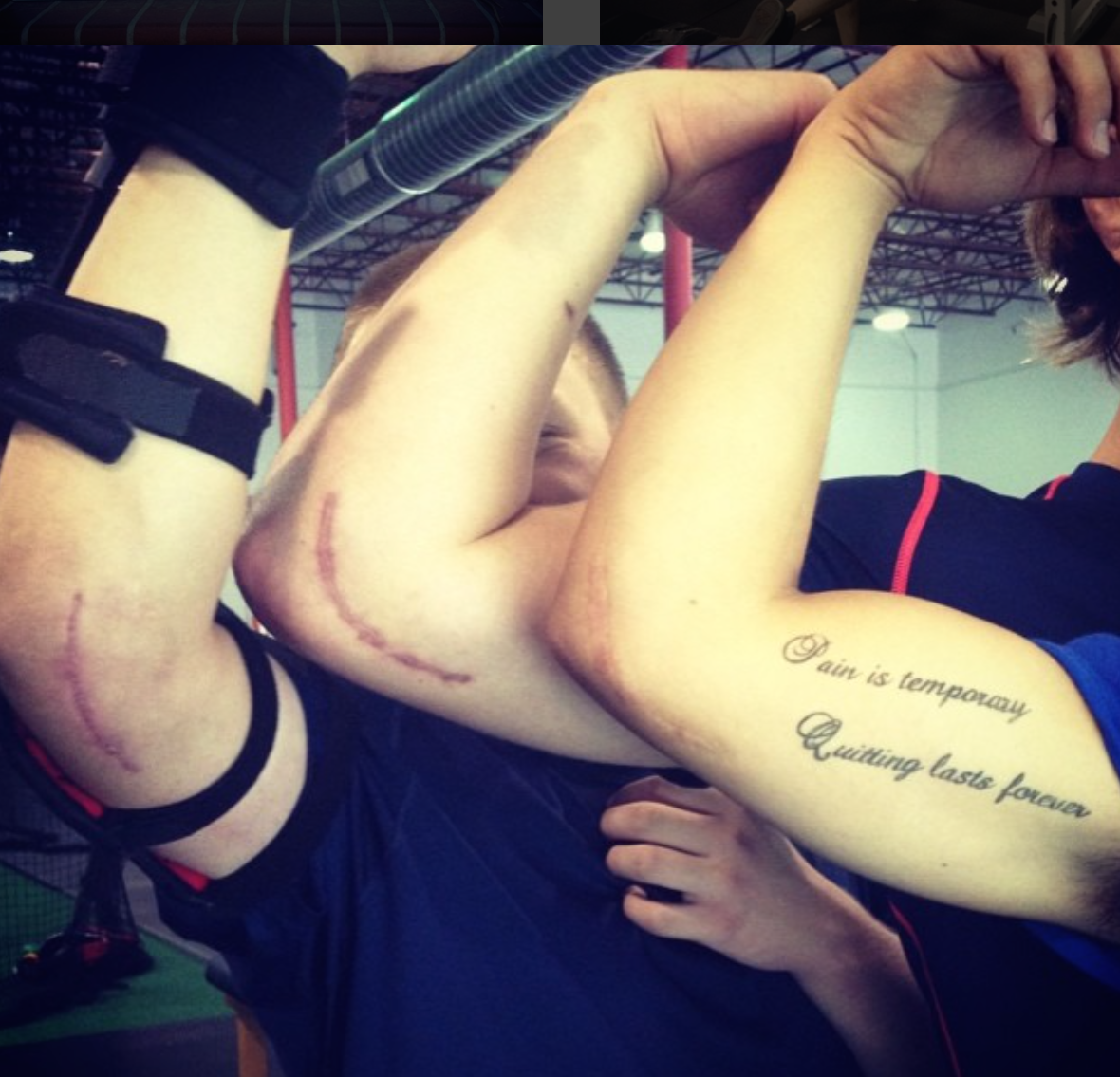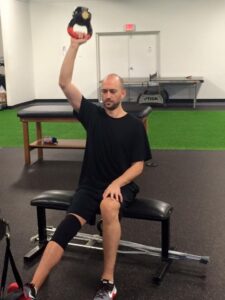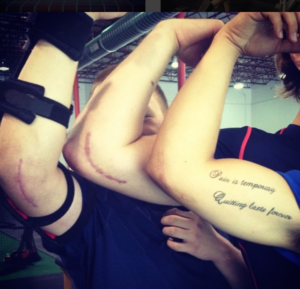
Making the Case for Training in the Post-Surgery Period
If you were to spend a day at either the MA or FL Cressey Sports Performance location, invariably, you’d see something that might surprise you: athletes training in spite of the fact that they recently had surgery. On a regular basis, we have athletes referred our way after everything from Tommy John surgeries to knee replacements. They may be on crutches, using an ankle boot, in an elbow brace, wearing a shoulder sling, or even rocking a back brace. Working with post-operative athletes has become a big niche for us; we work hand-in-hand with surgeons and rehabilitation specialists to make sure that we deliver a great training effect in spite of these athletes’ short-term limitations.

Unfortunately, athletes will sometimes run across hyper-protective therapists and doctors who are overly cautious in this period. Certainly, for a period, this is incredibly important, as there are risks of not only the repair being vulnerable to movements and direct pressure, but also it being compromised by infection in the first few weeks. However, in my opinion, it’s absolutely unnecessary to tell an athlete to just take 3-4 months off completely from exercise and instead just “rehab” – and yes, I have heard this before.
With this in mind, I wanted to outline six reasons I think strategically implemented strength and conditioning work in the post-surgery period is incredibly important.
1. It’s important to make an athlete feel like an athlete, not a patient.
There is a different vibe in a physical therapy clinic or training room as compared to a strength and conditioning setting. This isn’t intended to be a knock on rehabilitation specialists, but athletes would rather hang out in the latter realm! And, while great therapists make rehabilitation upbeat and keep the athlete’s competitive psyche engaged, getting back into the gym affords a big mental boost – a break from their current physical reality – for athletes.
Speaking of mental boosts, I won’t even bother to highlight the favorable impacts of exercise on mood and the reduction in risk of a wide variety of chronic diseases. Suffice it to say that there are a ton, and it’s important that athletes continue to have these benefits during their rehabilitation period. If you really want to dig deeper, I’d highly recommend this recently published meta-analysis: Exercise as a treatment for depression.
2. Small hinges swing big doors in terms of behaviors.
Most people eat healthier when they train. Whether this is conscious or subconscious is dependent on the individual, but it’s something I’ve seen time and time again.
Likewise, many student athletes perform better in the classroom when exercising regularly, and struggle to stay on task when they’re given too much free time.
What’s my point? Effectively, training pushes out certain bad behaviors. Likewise, on a physiological level, it supports better brain activity that makes for more productive members of society.
3. Injuries don’t occur in isolation.
Pitchers don’t just blow out their elbows because of functional deficits at the elbow. Rather, the elbow usually gets thrown under the bus from a collection of physical deficits all along the kinetic chain. As an example, Garrison et al (2013) demonstrated that players with ulnar collateral ligament tears scored significantly worse on the Y-balance test than their healthy peers.

With this in mind, it would be silly to spend months and months only focusing on rehabilitating the arm to the exclusion of the rest of the body. Unfortunately, physical therapists only have so much time with athletes because of insurance restrictions, so they may not get to these important complementary rehabilitation approaches. This is a great place for a competent strength and conditioning professional to pick up the slack.
4. Training improves body composition, which facilitates a number of favorable outcomes.
It drives me bonkers when I hear about an individual dropping a bunch of muscle mass and gaining substantial body fat during the post-surgery period. This should never happen.
Just as a healthy body composition will help a grandfather avoid setbacks following a hip replacement, having a good strength-to-body weight ratio will increase the likelihood that a college soccer player will avoid setbacks after a meniscal repair.
These benefits aren’t just conferred to weight-bearing scenarios. Remember, obesity is arguably the biggest limitation to diagnostic imaging accuracy. In other words, if you have a setback in your rehabilitation and need an MRI or x-ray, being fatter makes it hard for your radiologist to give you an accurate reading. An ounce of prevention is worth a pound of cure.
5. Exercise facilitates motor learning improvements.
When rehabbing, you’re trying to acquire new, favorable movement patterns. Research (good reads here and here) has demonstrated improved motor learning when new tasks are introduced alongside exercise (particularly aerobic exercise).
Maintaining a robust aerobic system and solid work capacity makes rehabilitation efforts more effective.
6. Contralateral strength training has carryover to immobilized limbs.
Via a mechanism known as cross-transfer (or cross-education), an untrained limb’s performance improves when the opposite limb is trained. As an example, if you have knee surgery on your right leg, but do what you can do to safely train your left leg while your right knee is immobilized, you’ll still get carryover to the post-surgery (right) side. It won’t do much to attenuate the atrophy of muscle mass on an immobilized limb, but it will absolutely reduce the fall-off in strength, power, and proprioception. Effectively, it’s “free rehab” that offers a huge leg up with respect to return to play.
As an aside, research on cross-transfer from Hortobagyi et al has demonstrated that the strength carryover seems to be stronger with eccentric exercise, so prioritizing this approach seems to have extra merit.
Some Important Notes
Before I sign off on this one, I should be clear on a few things:
1. Not every trainer and strength and conditioning coach is prepared to take on every injury.
If you’ve never heard the word “spondylolysis,” you shouldn’t be programming for a kid in a back brace. And, if you don’t know the difference between an ulnar nerve transposition and an ulnar collateral ligament reconstruction, you’re not ready to take on a post-op baseball elbow. Don’t be a cowboy.
2. Effective post-operative training mandates outstanding communication.
You should be speaking on a regular basis with the physical therapist or athletic trainer who is overseeing the rehabilitation plan. They’ll let you know if an athlete is prepared for progressions, and also to help you avoid overlapping with what they do in the rehabilitation sessions. I’d even encourage you to sit in on some of their rehabilitation sessions not only to monitor progress, but also as continuing education.
3. When in doubt, hold athletes back.
One of my graduate school professors, Dr. David Tiberio, once said that physical therapists “should be as aggressive as possible, but do no harm.” I’ll take this a step further and say that fitness professionals conditioning “should be conservative and do no harm” during the rehabilitation process. It’s our job to maintain/improve fitness and facilitate return-to-play, but in no way set back the recovery process. In short, let the rehab folks take all the chances when it comes to progressions.
4. Remember that progressions occur via many avenues.
Progressions don’t just come in terms of exercise selection, but also absolute loading, speed of movement, volume, frequency, duration, and a host of other factors. You need to keep all of them in mind when programming and coaching, as even one factor that is out of whack can set a rehabilitation program back. Additionally, there will be times when stress in one area goes up, which means it must be reduced in another area. As an example, during rehabilitation from Tommy John surgery, the stress on the medial elbow increases when an athlete begins throwing at the 4-6 month mark, and many athletes will benefit from a reduction in the amount of gripping they do in their strength training and rehabilitation programs.

5. Watch for “accidental” stabilization demands.
Many muscles work reflexively, with the rotator cuff being the absolute best example. After a shoulder surgery, you have to be careful training the opposite side too soon (or with too much loading) because the cuff on the surgery side can turn on reflexively. As the aforementioned cross-transfer effect dictates, it’s not as simple as right vs. left training effects; our nervous system governs everything – and in curious ways.
Wrap-up
I hope that in publishing this article, I made a strong case for the importance of appropriate exercise during the post-surgery period. Remember that what is “appropriate” will be different for each individual, and should be determined via a collaborative effort with input from a surgeon, rehabilitation specialist, strength and conditioning professional, and the athlete. And, it should always be a fluid process that can be progressed or regressed based on how the athlete is doing.
For the fitness professionals out there, if you’re looking for more information, here are a few good reads:
4 Reasons You Must Understand Corrective Exercise and Post-Rehab Training
7 Random Thoughts on Corrective Exercise and Post-Rehab Training


